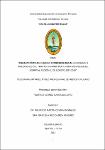| dc.contributor.advisor | Casapía Morales, Wilfredo Martín | |
| dc.contributor.advisor | Meza Sánchez, Graciela Rocío | |
| dc.contributor.author | Carbajal López, Rodrigo Alonso | |
| dc.date.accessioned | 2018-10-03T17:29:17Z | |
| dc.date.available | 2018-10-03T17:29:17Z | |
| dc.date.issued | 2018 | |
| dc.identifier.other | 616.6 C26 2018 | es_PE |
| dc.identifier.uri | http://repositorio.unapiquitos.edu.pe/handle/20.500.12737/5622 | |
| dc.description.abstract | Objetivo: Determinar las características clínicas y epidemiológicas asociadas a infecciones de tracto urinario por uropatógenos BLEE, en el Hospital Regional de Loreto, en el período de enero 2017 – junio 2018.
Materiales y métodos: Estudio de tipo observacional, analítico, transversal y de fuente secundaria. La población estuvo conformada por los pacientes adultos hospitalizados, con diagnóstico de infección del tracto urinario, que cuenten con urocultivo positivo, tanto para uropatógenos BLEE y no BLEE, en el período de enero 2017 – junio 2018. Se hizo uso de técnicas documentarias, elaborando una ficha de recolección de datos, que fue sometida a juicio de expertos. Los datos fueron procesados con el software estadístico SPSS versión 25.
Resultados: De los 117 pacientes en el estudio, se aisló uropatógenos BLEE en 81 pacientes (69,2%). Escherichia coli y Klebsiella pneumoniae, son las bacterias más frecuentemente aisladas. El rango de edad de 18 a 45 años, el sexo femenino y la procedencia de zona urbana, fueron las características epidemiológicas más frecuente, pero sin significancia estadística. Se obtuvo en el análisis bivariado: el tipo de bacteria, antibioticoterapia previa, tipo de antibiótico, hospitalización previa, uso de dispositivo urológico, ITU previa, ITU recurrente, comorbilidades y gestación, son características clínicas asociadas a ITU BLEE. El tipo de antibiótico previo más utilizado fue el grupo de las cefalosporinas (49,6%).
Conclusiones: No existe asociación estadísticamente significativa, entre las características epidemiológicas y las ITU BLEE. Existe asociación estadísticamente significativa entre el tipo de bacteria, antibioticoterapia previa, tipo de antibiótico, hospitalización previa, uso de dispositivo urológico, ITU previa, ITU recurrente, comorbilidades y gestación, y las ITU BLEE. | es_PE |
| dc.description.abstract | Objective: To determine the clinical and epidemiological characteristics associated with urinary tract infections by uropathogens ESBL, in the Regional Hospital of Loreto, in the period of January 2017 - June 2018.
Materials and methods: Observational, analytical, transversal and secondary source study. The population consisted of hospitalized adult patients, with a diagnosis of urinary tract infection, who had a positive urine culture, both for ESBL and non-ESBL uropathogens, in the period of January 2017 - June 2018. Document techniques were used, elaborating a data collection form, which was submitted to expert judgment. The data were processed with the statistical software SPSS version 25.
Results: Of the 117 patients in the study, ESBL uropathogens were isolated in 81 patients (69.2%). Escherichia coli and Klebsiella pneumoniae, are the most frequently isolated bacteria. The age range of 18 to 45 years, female sex and origin of urban area, were the most frequent epidemiological characteristics, but without statistical significance. It was obtained in the bivariate analysis: the type of bacteria, previous antibiotic therapy, type of antibiotic, previous hospitalization, use of urological device, previous UTI, recurrent UTI, comorbidities and gestation, are clinical characteristics associated with UTI - ESBL. The most commonly used type of antibiotic was the group of cephalosporins (49.6%).
Conclusions: There is no statistically significant association between epidemiological characteristics and ESBL UTIs. There is a statistically significant association between the type of bacteria, previous antibiotic therapy, type of antibiotic, previous hospitalization, use of urological device, previous UTI, recurrent UTI, comorbidities and gestation, and ESBL UTI´s. | en_US |
| dc.description.uri | Tesis | es_PE |
| dc.format | application/pdf | es_PE |
| dc.language.iso | spa | es_PE |
| dc.publisher | Universidad de la Amazonía Peruana | es_PE |
| dc.rights | info:eu-repo/semantics/openAccess | es_PE |
| dc.rights | Attribution-NonCommercial-NoDerivs 3.0 United States | * |
| dc.rights.uri | http://creativecommons.org/licenses/by-nc-nd/3.0/us/ | * |
| dc.source | Universidad Nacional de la Amazonía Peruana | es_PE |
| dc.source | Repositorio institucional - UNAP | es_PE |
| dc.subject | Infecciones urinarias | es_PE |
| dc.subject | Betalactamasas | es_PE |
| dc.subject | Diagnóstico clínico | es_PE |
| dc.subject | Factores epidemiológicos | es_PE |
| dc.title | Características clínicas y epidemiológicas asociadas a infecciones del tracto urinario por uropatógenos blee, hospital regional de Loreto 2017-2018 | es_PE |
| dc.type | info:eu-repo/semantics/bachelorThesis | es_PE |
| thesis.degree.discipline | Medicina Humana | es_PE |
| thesis.degree.grantor | Universidad Nacional de la Amazonía Peruana. Facultad de Medicina Humana | es_PE |
| thesis.degree.level | Título Profesional | es_PE |
| thesis.degree.name | Médico Cirujano | es_PE |
| thesis.degree.program | Regular | es_PE |
| dc.subject.ocde | http://purl.org/pe-repo/ocde/ford#3.02.20 | es_PE |


